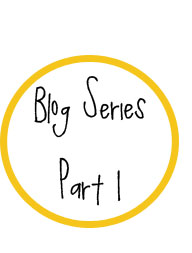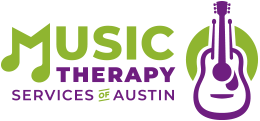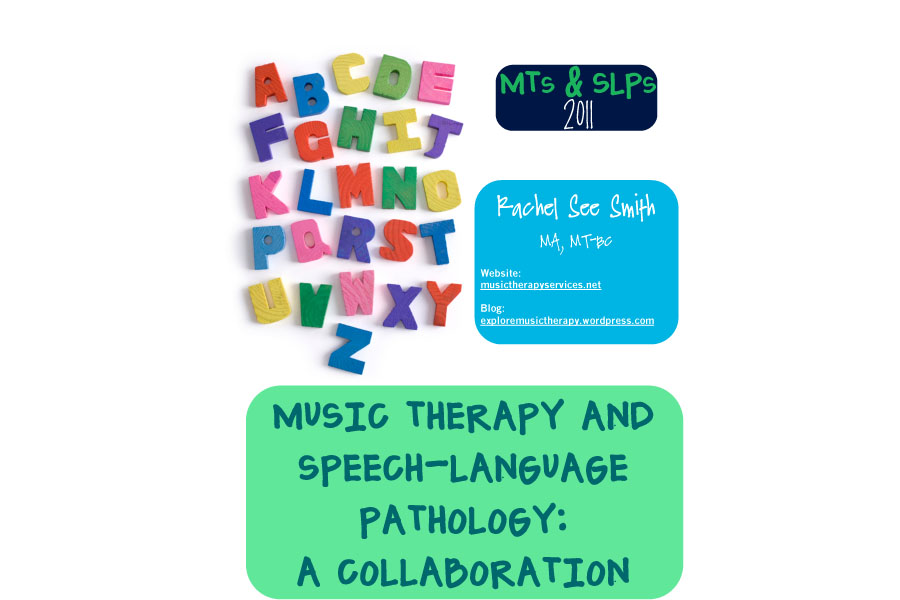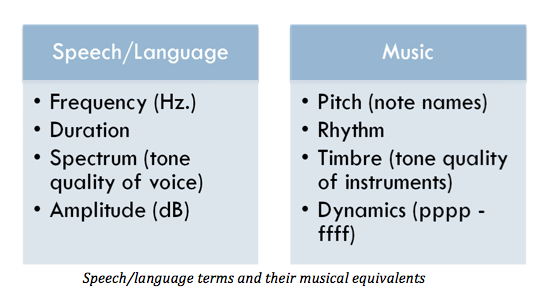Blog Series on SLP and MT Collaboration: Part 1
The purpose of this blog series is to advocate for the collaboration of speech therapy and music therapy.
(If you missed the list of the blog posts that will be included in this series, click here!)

Part 1 will provide a basic overview of speech therapy and music therapy, as well as the connection between music and language.
First, let’s look at the basics. What is the basic connection between music and speech?
Q. Music and Speech: How are these forms of communication related?
A. There are many similarities between speech/language and music. For example, in both speech and music, frequency, duration, and timbre elements unfold over time to convey a message. Both of these communication tools utilize prosodic information, such as inflection and phrasing, to help portray the meaning of this message (Donnelly, 2001).
The musical aspects of language include melodic contour, timbre variations, motherese or infant-directed speech, rhythm, and nonverbal aspects of language.
Because these forms are so closely related, it is my opinion that a successful collaboration of two therapies related to music and speech — Speech-Language Pathology and Music Therapy — would be extremely beneficial for the client.
What is Speech-Language Pathology?
According to the ASHA Website,
Working with the full range of human communication and its disorders, speech-language pathologists (SLPs):
- Evaluate and diagnose speech, language, cognitive-communication and swallowing disorders
- Treat speech, language, cognitive-communication and swallowing disorders in individuals of all ages, from infants to the elderly
Examples of speech and language disorders: Articulation disorders, phonological disorders, speech/language impairment, and/or receptive/expressive language difficulty. Additionally, the SLP may work on expressive or receptive language difficulties related to a hearing loss (client may be wearing a hearing aid from places like https://www.earpros.com/hearing-aid-brands/starkey-hearing-aids or cochlear implant).
What is music therapy?
According to the AMTA Website,
Music Therapy is the clinical and evidence-based use of music interventions to accomplish individualized goals within a therapeutic relationship by a credentialed professional who has completed an approved music therapy program.
So, why would music therapy services be beneficial in terms of SLP collaboration?
Knowing that one auditory training task could transfer to and enhance other auditory activities, there are many implications for using music therapy to address language and speech goals.
Music is:
– Structured
– Predictable
– Repetitive
Songs and instrument play can be used to address:
Oral motor skills
Speech articulation
Language Acquisition
Length of Utterance
Social Skills
Language concepts
…and more!
The majority of music is structured, predictable, and repetitive and can provide rhythmic and melodic cues. Vocal flexibility, vocal imitation, and vocabulary reinforced through song lyrics, are all speech goals that can be addressed with music. These goals can be addressed through rhythm, rhyme, turn-taking (just like in conversation), and repetition. Relaxation exercises, song articulation experiences, and word/phrase rhythm chanting experiences are all strategies in which music can be used to address speech goals (Zoller, 1991). Music can assist breath and muscle control (Peters, 2000; Cohen, 1994), help the patient practice receptive and expressive language skills (Miller, 1982), and enhance articulation skills (Zoller, 1991). Self-esteem, confidence, attention, and listening skills can all be enhanced through music, as well.
Pairing Augmentative and Alternative Communication (AAC) strategies with musical strategies has also been shown to help with social communication skills (Herman 1985). Signing and manual communication systems can be used to express song lyrics and signs paired with singing can be used together for total communication experiences (Darrow, 1987a). Studies have shown that children with autism learned more signs when they were paired with music and speech than when they were taught with music alone or speech alone (Buday, 1995).
Other methods to incorporate speech and language goals and music may include:
Melodic Intonation Therapy (MIT), Speech Stimulation (STIM), and Therapeutic Singing (TS)
In order to incorporate and implement some of the patient’s speech goals into the music therapy session, collaboration is a necessity. According to Register (2002), of the 695 music therapists questioned, 44.6% said that they collaborate with SLPs. Collaborating with the family, educators, doctors, speech pathologists, psychologists, therapists, social workers and other professionals that are involved in the patient’s daily life is key to their language-learning success (Rychener Hobson, 2006). Making sure everyone is on the same page and supporting the patient’s needs with a wide variety of specialties and activities can truly make an impact on the patient’s improvement.
CLICK HERE to view and download the .pdf of the percentage breakdown of music therapy and speech therapy collaboration
References (Free .pdf download)
Author Bio: Rachel See Smith is a board-certified music therapist (MT-BC) with a Master’s in music therapy and a B.A. in Communication Disorders. Her undergraduate background in speech pathology has continually played a supportive role in her ongoing music therapy endeavors. See Smith has had extensive experience using music therapy with children with communication disorders, including several music therapy practica with children in a speech therapy preschool program (KidTalk), co-leading music therapy sessions for children with hearing aids and cochlear implants at a summer program in the speech and hearing clinic (Listen and Speak Up), and having the opportunity to be a research assistant for Dr. Kate Gfeller’s Music Perception Team in the Department of Otolaryngology at the University of Iowa Hospitals and Clinics, which involved researching music perception abilities and preferences of children and adults with cochlear implants. The idea of successful collaboration practices between music therapists and speech and language therapists has been, and will continue to be, Rachel’s passion.
Comments are closed.






I think collaboration between professions is an incredibly cool idea that doesn’t seem to be done to often. I know that Kim (my business partner) and I have been having lots of conversations about creating opportunities for collaboration in our new private practice. I absolutely love that this is a topic you are focusing on so thoroughly! Looking forward to reading more!! 🙂
Thanks!
Thanks so much!! It’s definitely a passion of mine and I truly believe that collaboration would be incredibly effective for the client. Good luck in your new private practice adventures — keep me posted if you do any collaboration/co-treating – I’d love to hear about it!